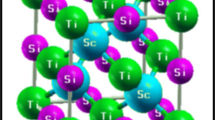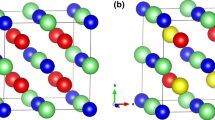Abstract
In this paper, we report some physical properties of Half-Heusler ScVX (X = Si, Ge, Sn, and Pb) compounds using the first-principle investigations employing density functional theory (DFT) within the WIEN2k. Simulations are carried out using the generalized gradient approximation with the addition of the Hubbard U-term (GGA + U), which takes into consideration the effect of on-site Coulombic interactions. All the compounds are found structurally stable, having an optimized phase. The optimum lattice constants, according to the calculations for these compounds, are 6.0206 Å, 6.255 Å, 6.561 Å, and 6.64 Å for ScVX (X = Si, Ge, Sn, and Pb), respectively. Spin-polarized calculations (i.e., spin-up and spin-down) are carried out and in the electronic properties, it is noted that all these compounds possess a small band gap in the spin-down configuration. While in spin-up (spinning the majority channel), the metallic nature is confirmed. As a result, all compounds are half-metallic and are 100 percent spin-polarized at the Fermi level. Elastic properties show that, except the ScVPb, all investigated compounds are ductile. All Half-Heusler ScVX (X = Si, Ge, Sn, and Pb) compounds are highly anisotropic. The total magnetic moments of all compounds exceed 3 μB, thus all compounds exhibit strong ferromagnetic behavior, and the magnetic moment is primarily generated by the Vanadium (V) atom. Furthermore, the ferromagnetic phase is determined to be more energetically advantageous than the paramagnetic phase. As a result, ScVX (X = Si, Ge, Sn, and Pb) compounds are attractive materials for future spintronics applications.




Similar content being viewed by others
Data availability statement
The data that support the findings of this study are available from the corresponding author upon reasonable request.
References
I. Galanakis, P. Mavropoulos, Zinc-blende compounds of transition elements with N, P, As, Sb, S, Se, and Te as half-metallic systems. Phys. Rev. B 67(10), 104417 (2003)
H. Xie et al., Beneficial contribution of alloy disorder to electron and phonon transport in half-heusler thermoelectric materials. Adv. Funct. Mater. 23(41), 5123–5130 (2013)
N. Rahman et al., First principle study of structural, electronic, elastic, and magnetic properties of half-heusler compounds ScTiX (X= Si, Ge, Pb, In, Sb, and Tl). J. Supercond. Nov. Magn. 33(12), 3915–3922 (2020)
J.-W.G. Bos, R.A. Downie, Half-Heusler thermoelectrics: a complex class of materials. J. Phys. Condens. Matter. 26(43), 433201 (2014)
F. Casper, T. Graf, S. Chadov, B. Balke, C. Felser, Half-Heusler compounds: novel materials for energy and spintronic applications. Semicond. Sci. Technol. 27(6), 63001 (2012)
A. Amudhavalli, R. Rajeswarapalanichamy, K. Iyakutti, Half metallic ferromagnetism in Ni-based half Heusler alloys. Comput. Mater. Sci. 148, 87–103 (2018)
W.E. Pickett, J.S. Moodera, Half metallic magnets. Phys. Today 54(5), 39–45 (2001)
B. Sanyal, O. Eriksson, K.G. Suresh, I. Dasgupta, A.K. Nigam, P. Nordblad, Ferromagnetism in Mn-doped half-Heusler NiTiSn: Theory and experiment. Appl. Phys. Lett. 89(21), 212502 (2006)
A. Lakdja, H. Rozale, A. Chahed, O. Benhelal, Ferromagnetism in the half-heusler XCsBa compounds from first-principles calculations (X= C, Si, and Ge). J. Alloys Compd. 564, 8–12 (2013)
J. Chen, G.Y. Gao, K.L. Yao, M.H. Song, Half-metallic ferromagnetism in the half-Heusler compounds GeKCa and SnKCa from first-principles calculations. J. Alloys Compd. 509(42), 10172–10178 (2011)
R.A. De Groot, F.M. Mueller, P.G. Van Engen, K.H.J. Buschow, New class of materials: half-metallic ferromagnets. Phys. Rev. Lett. 50(25), 2024 (1983)
K. Kenmochi, M. Seike, K. Sato, A. Yanase, H. Katayama-Yoshida, New class of diluted ferromagnetic semiconductors based on CaO without transition metal elements. Jpn. J. Appl. Phys. 43(7A), L934 (2004)
K. Kenmochi, V. Ann Dinh, K. Sato, A. Yanase, H. Katayama-Yoshida, Materials design of transparent and half-metallic ferromagnets of MgO, SrO, and BaO without magnetic elements. J. Phys. Soc. Japan 73(11), 2952–2954 (2004)
M. Petersen, F. Wagner, L. Hufnagel, M. Scheffler, P. Blaha, K. Schwarz, Improving the efficiency of FP-LAPW calculations. Comput. Phys. Commun. 126(3), 294–309 (2000)
E. Jacobsen, R. Lyons, The sliding DFT. IEEE Signal Process. Mag. 20(2), 74–80 (2003)
I.B. Obot, D.D. Macdonald, Z.M. Gasem, Density functional theory (DFT) as a powerful tool for designing new organic corrosion inhibitors. Part 1: an overview. Corros. Sci. 99, 1–30 (2015)
P. Blaha, K. Schwarz, G.K.H. Madsen, D. Kvasnicka, J. Luitz, wien2k. An Augment. Pl. wave+ local orbitals Progr. Calc. Cryst. Prop., 60, (2001)
L. Li, K. Burke, Recent developments in density functional approximations, in Handbook of Materials Modeling: Methods: Theory and Modeling. ed. by W. Andreoni, S. Yip (Springer International Publishing, Cham, 2018), pp. 1–14
U. Von Barth, L. Hedin, A local exchange-correlation potential for the spin polarized case. i. J. Phys. C Solid State Phys. 5(13), 1629 (1972)
M.M. Pant, A.K. Rajagopal, Theory of inhomogeneous magnetic electron gas. Solid State Commun. 10(12), 1157–1160 (1972)
F.D. Murnaghan, The compressibility of media under extreme pressures. Proc. Natl. Acad. Sci. USA 30(9), 244 (1944)
M. Jamal, M. Bilal, I. Ahmad, S. Jalali-Asadabadi, IRelast package. J. Alloys Compd. 735, 569–579 (2018)
B. Nanda, I. Dasgupta, Electronic structure and magnetism in half-Heusler compounds. J. Phys.: Condens. Matter. 15, 7307 (2003)
I. Galanakis, P. Mavropoulos, P.H. Dederichs, Electronic structure and Slater-Pauling behaviour in half-metallic Heusler alloys calculated from first principles. J. Phys. D. Appl. Phys. 39(5), 765 (2006)
P. Ravindran, L. Fast, P.A. Korzhavyi, B. Johansson, J. Wills, O. Eriksson, Density functional theory for calculation of elastic properties of orthorhombic crystals: Application to TiSi 2. J. Appl. Phys. 84(9), 4891–4904 (1998)
I.N. Frantsevich, F.F. Voronov, S.A. Bokuta, in Elastic constants and elastic moduli of metals and insulators, ed. by I.N. Frantsevich, Naukova Dumka, Kiev (1983), p. 60–180.
R.P. Thompson, W.J. Clegg, Predicting whether a material is ductile or brittle. Curr. Opin. Solid State Mater. Sci. 22(3), 100–108 (2018)
V. Tvergaard, J.W. Hutchinson, Microcracking in ceramics induced by thermal expansion or elastic anisotropy. J. Am. Ceram. Soc. 71(3), 157–166 (1988)
Author information
Authors and Affiliations
Corresponding authors
Rights and permissions
About this article
Cite this article
Abdullah, A., Husain, M., Rahman, N. et al. Computational investigation of structural, magnetic, elastic, and electronic properties of Half-Heusler ScVX (X = Si, Ge, Sn, and Pb) compounds. Eur. Phys. J. Plus 136, 1176 (2021). https://doi.org/10.1140/epjp/s13360-021-02175-4
Received:
Accepted:
Published:
DOI: https://doi.org/10.1140/epjp/s13360-021-02175-4




